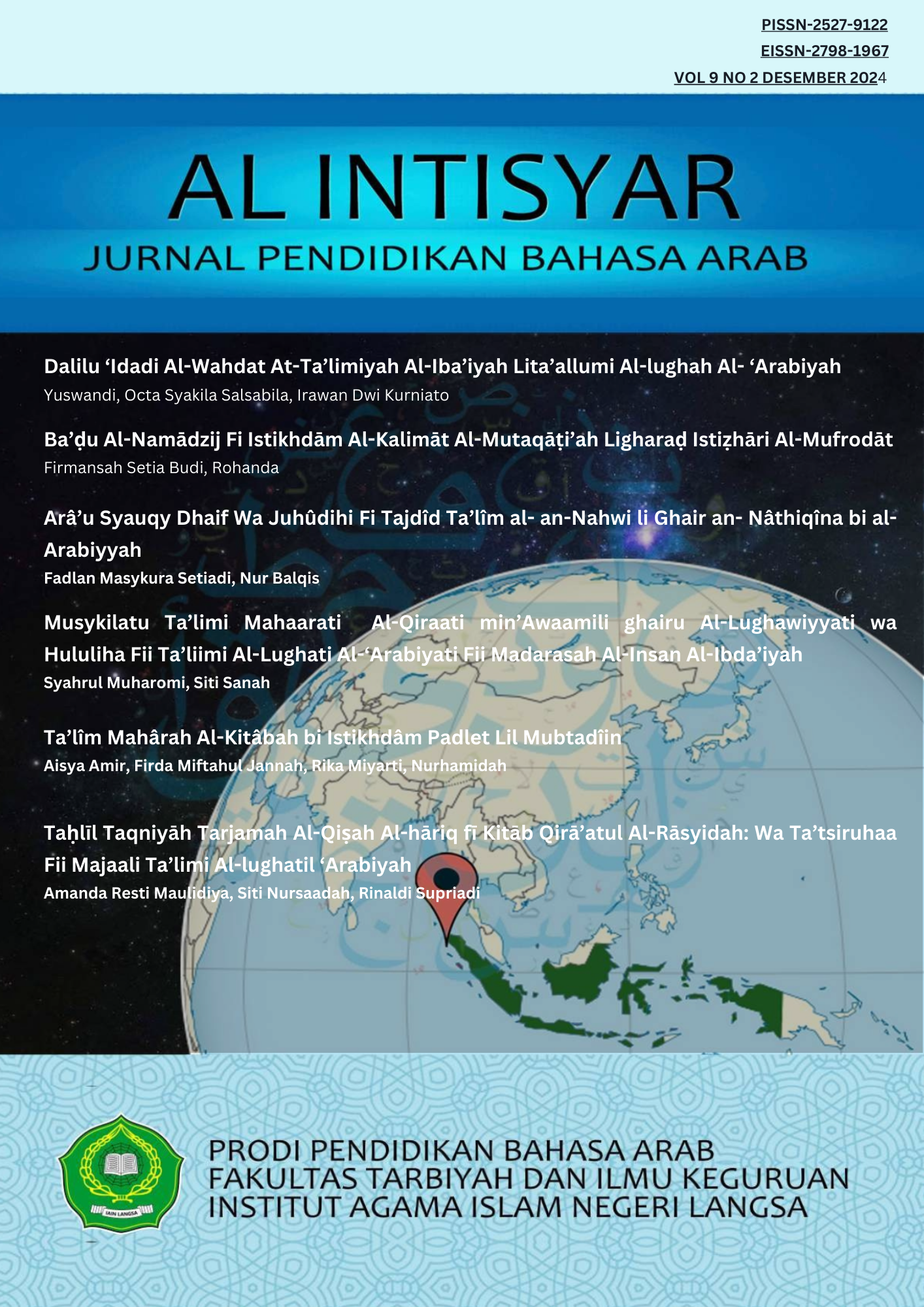Main Article Content
Abstract
In this era, online learning has become an essential part of our lives. The internet, as an educational tool, helps and facilitates students' access to numerous resources. It is especially useful for learning the Arabic language. One of the technological tools available online is Padlet, which is a message board where users can post and store various types of content, including videos, images, websites, GIFs, and text. The purpose of this study is to describe the Padlet program and its application in teaching Arabic writing skills to beginners. This study follows a descriptive analysis methodology, as developed by Mills and Haberman, and includes three main stages: data collection, presentation, and conclusion. The results of this study demonstrate that Padlet not only helps students acquire beginner writing skills but also aids in the development of their writing proficiency and boosts their confidence by providing an interactive and supportive environment with detailed examples of various activities. Students can freely share their ideas, receive instant feedback from teachers and peers, and learn by observing others' work.Teaching methods, Writing skills, Padlet programme
Keywords
Article Details
References
- Farrah, M., & Tushyeh, H. (2010). Enhancing the English Reading and Writing Skills of Palestinian English Majors by Using CALL. Hebron University Research Journal, 5(2), 259–282.
- Grégoire, R., Bracewell, R., & Laferrière, T. (1996). The Contribution of New Technologies to Learning and Teaching in Elementary and Secondary Schools. Kanada: Laval University.
- McCarthy, J. (2010). Blended Learning Environments: Using Social Networking Sites to Enhance the First Year Experience. Australasian Journal of Educational Technology, 26(6), 729–740.
- Ni’mah, A. waha. rosyidi dan mamlu’atul. (2012). Memahami konsep dasar pembelajaran bahasa arab. UIN Maliki.
- Sivin-Kachala, J. & Bialo, E. (2000). 2000 Research Report on the Effectiveness of Technology in Schools (7th ed.). Washington: Software Publisher’s Association.
- Sugiyono. (2020). Metode Penelitian kualitatif. Bandung: Alfabeta.
- Vi, V. T. (2005). Advantages and Disadvantages of Using Computer Network Technology in Language Teaching.
- Watkins, A. (2007). Using Digital Technology to Enhance Creativity in Reading and Writing. University Teaching Conference.
- Yunus, M. M., & Salehi, H. (2012). The Effectiveness of Facebook Groups on Teaching and Improving Writing: Students’ Perceptions. International Journal of Education and Information Technologies, 6(1), 87–96.
- Yusuf, M. (2016). Metode Penelitian Kuantitatif, Kualitatif & Penelitian Gabungan. Jakarta: Kencana.
- Ø£Øمد, Ù…. ز. (1987). وسائل وتكنولوجيا التعليم. عمان: دار التربية الØديثة.
- الØلاق, Ù‡. س., & النصرواي, Ù…. Ù…. (2008). كي٠نجعل أساليب التدريس أكثر تشويقا للمتعلم (Ø·.1). المدينة المنورة: كمتبة دار الزمان للنشر والتوزيع.
- العمري, Ù…. ع. ا. (1989). وسائل وتقنيات التعليم ÙÙŠ عملية التعليم والتعلم. الأردن: جامعة اليرموك.
- الÙوزان, ع. ا. ب. Ø¥. (2011). إضاءات لمعلمي اللغة العربية لغير الناطقين بها. الرياض: المملكة العربية السعودية.
- الكامل, Ù…. ع. (2011). لتعليم المهارات اللغوية لغير الناطقين بها. جامعة مولنا ملك ابراهيم الاسلامية الØكومية.
- الله, Ù…. Ø¥. ص. Ùˆ. ا. ع. (1984). المعينات البصرية ÙÙŠ تعليم اللغة. جامعة الملك سعود, الرياض.
- الناقة, ر. Ø£. Ø·. Ù…. Ùƒ. (2003). طرائق تدريس اللغة العربية لغير الناطقين بها. مصر: منظمة الإسلامية للتربية والعلوم والثقاÙØ©.
- الناقة, م. ك. (1985). تعليم اللغة العربية للناطقين بلغات أخرى. مملكة العربية السعودية: كلية التربية جامعة عين شمس.
- Øمدان, Ù…. ز. (1985). ترشيد التدريس بمبادئ Ùˆ استراتيجيات Ù†Ùسية Øديثة. عمان ( الاردن): دار التربية الØديثة.
- طعيمة, ر. Ø£., مدكور, ع. Ø£., & هريدي, Ø¥. Ø£. (2010). المرجع ÙÙŠ مناهج تعليم اللغة العربية للناطقين بلغات أخرى (Ø·.1). القاهرة: دار الÙكر العربي.
- عبد الرØمن بن إبراهيم الÙوزان, Øسين, Ù…. ا., & Ùضل, Ù…. ع. ا. Ù…. (1345). المعجم العربي بين يديك. المملكة العربية السعودية.
